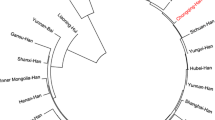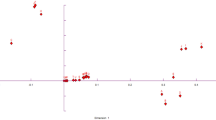Abstract
Short tandem repeats (STRs) play a vitally important role in forensics. Population data is needed to improve the field. There is currently no large population data-based data set in Chamdo Tibetan. In our study, the allele frequencies and forensic statistical parameters of 18 autosomal STR loci (D5S818, D21S11, D7S820, CSF1PO, D2S1338, D3S1358, VWA, D8S1179, D16S539, PentaE, TPOX, TH01, D19S433, D18S51, FGA, D6S1043, D13S317, and D12S391) included in the DNATyper™19 kit were investigated in 2249 healthy, unrelated Tibetan subjects living in Tibet Chamdo, Southwest China. The combined power of discrimination and the combined probability of exclusion of all 18 loci were 0.9999999999999999999998174 and 0.99999994704, respectively. Furthermore, the genetic relationship between our Tibetan group and 33 previously published populations was also investigated. Phylogenetic analyses revealed that the Chamdo Tibetan population is more closely related genetically with the Lhasa Tibetan group. Our results suggest that these autosomal STR loci are highly polymorphic in the Tibetan population living in Tibet Chamdo and can be used as a powerful tool in forensics, linguistics, and population genetic analyses.
Similar content being viewed by others
Change history
26 February 2020
‘Concerns have been raised about the ethics approval and informed consent procedures related to the research reported in this paper. The paper includes the following author declarations: “Informed consent of all participating subjects was obtained, and this work was approved by the Ethics Committee of the Institute of Forensic Science, Ministry of Public Security, People’s Republic of China”. Editorial action will be taken as appropriate once an investigation of the concerns is complete and all parties have been given an opportunity to respond in full.’
References
Zhao F, Wu X, Cai G, Xu C (2003) The application of Modified-Powerstates software in forensic biostatistics. Chin J Forensic Med 18:297–298
Peakall R, Smouse PE (2012) GenAlEx 6.5: genetic analysis in Excel. Population genetic software for teaching and research—an update. Bioinformatics 28(19):2537–2539. https://doi.org/10.1093/bioinformatics/bts460
Excoffier L, Lischer HE (2010) Arlequin suite ver 3.5: a new series of programs to perform population genetics analyses under Linux and Windows. Mol Ecol Resour 10(3):564–567. https://doi.org/10.1111/j.1755-0998.2010.02847.x
Kumar S, Stecher G, Tamura K (2016) MEGA7: molecular evolutionary genetics analysis version 7.0 for bigger datasets. Mol Biol Evol 33(7):1870–1874. https://doi.org/10.1093/molbev/msw054
Acknowledgments
We thank all the participants in this study.
Author information
Authors and Affiliations
Corresponding author
Ethics declarations
Informed consent of all participating subjects was obtained, and this work was approved by the Ethics Committee of the Institute of Forensic Science, Ministry of Public Security, People’s Republic of China.
Conflict of interest
The authors declare that they have no conflict of interest.
Rights and permissions
About this article
Cite this article
Li, Z., Zhang, J., Zhang, H. et al. Genetic polymorphisms in 18 autosomal STR loci in the Tibetan population living in Tibet Chamdo, Southwest China. Int J Legal Med 132, 733–734 (2018). https://doi.org/10.1007/s00414-017-1740-1
Received:
Accepted:
Published:
Issue Date:
DOI: https://doi.org/10.1007/s00414-017-1740-1




